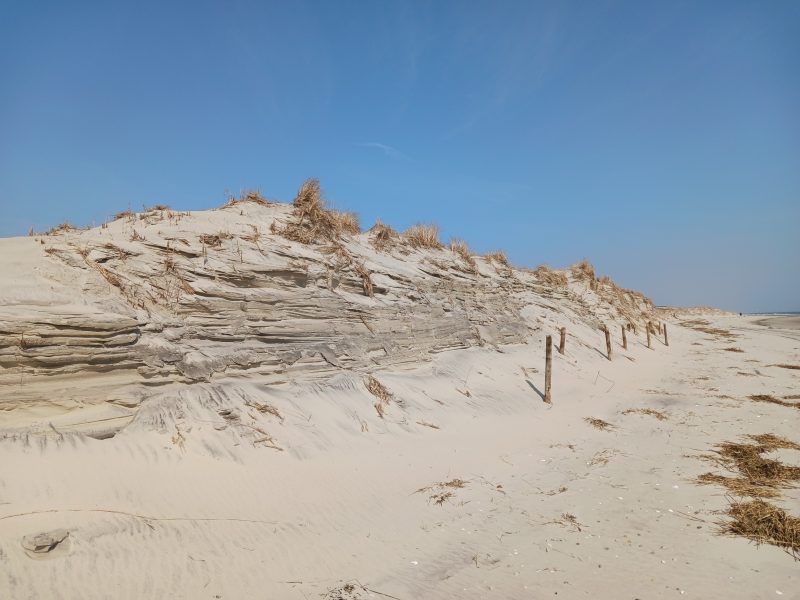By DONALD WITTKOWSKI
Mature pine trees have toppled onto the beach in a mini-avalanche of sand. Beach pathways have dead-ended in midair. Red “Danger” tape warns beachgoers to be careful.
This unusual scene, mere steps from the ocean at 88th and 89th streets in the south end of Sea Isle City, is the result of severe erosion that has robbed the beach and dunes of countless amounts of precious sand.
Other sections of the beach and dunes in Sea Isle also have been damaged by a series of coastal storms this winter and last fall that unleashed powerful waves carving away the shoreline.
Fortunately for Sea Isle, the U.S. Army Corps of Engineers will begin a much-awaited replenishment project in March to restore the depleted beaches in two sections of the island.
Mayor Leonard Desiderio announced during a City Council meeting Tuesday that an Army Corps of Engineers contractor will mobilize its equipment next week and is scheduled to begin sand-pumping operations by mid-March.
A floating dredge anchored offshore will collect sand from the sea bottom and pump it onto the beach through a massive pipe network.
In all, 252,000 cubic yards of new sand will be placed between 29th and 52nd streets in the mid part of the island and another 388,000 cubic yards between 74th and 94th streets in the south end.
“Currently, the contractor plans to complete the southern section first, with the entire project scheduled to be completed prior to Memorial Day weekend,” Desiderio said.
Based on that schedule, Sea Isle’s residents and tourists will enjoy wide, fluffy beaches throughout the all-important summer vacation season at the shore.
Steve Rochette, a spokesman for the Army Corps of Engineers, noted that beach replenishment projects are a vital way to protect shore communities from the damage inflicted by coastal storms.
“The purpose of these projects is to maintain the beach berm system and repair dunes in some cases. Having a functional berm and dune system in place is important to absorb energy from waves during storm events. It reduces the risk of storm damage to physical infrastructure such as homes, roads, utility lines, promenades, etc.,” Rochette said in an email.

Sea Isle is part of a $33.7 million project that also includes replenishing the storm-damaged beaches and dunes in the southern end of Ocean City and Strathmere. Sea Isle has approved a $3.2 million funding package to pay for its share of the project.
Although there is evidence of beach erosion across the island, nowhere is the damage worse than in the Townsends Inlet section in the far south end of town. Year after year, the beaches along the streets in the 80s and 90s usually get hammered – and that is the case this time around, too.
The heavily damaged beach and dunes at 88th Street and 89th Street are a prime example. These dunes serve as the first line of defense against the raging ocean for the multimillion-dollar beachfront homes in the area.
Some of the big pine trees that were perched on top of the once-healthy dunes have tumbled onto the beach at 88th and 89th streets because so much of the sand has been washed away.
The damaged dunes have turned into steep sand cliffs about 10 to 20 feet high. Some of the pathways leading to the beach over the dunes are unusable because the drop-offs are so sharp. They are suspended in midair.

In early January, Sea Isle City’s Public Works Department spread tons of sand near the jetty at 88th Street to level out a steep drop-off on the beach and create a pathway for vehicles. Public Works vehicles and people who have permits to drive on the beach, including fishermen, could not get through until the new sand was added.
Now, the same stretch of the 88th Street beach is badly eroded again. Red “Danger” tape has now been placed on the beach as a barrier to prevent anyone from driving there.
As a temporary measure, the city has done “sand harvesting” at different times to fortify the depleted dunes mainly between 88th and 92nd streets. Essentially, sand was scrapped from the water’s edge and pushed up against the dunes by earthmovers.
However, much of the harvested sand has since been washed away.








